Yoga Asanas, Yoga Postures
Asana is defined as “posture;” its literal meaning is “seat.” Originally, the asanas served as stable postures for prolonged meditation. More than just stretching, asanas open the energy channels, chakras and psychic centers of the body. Asanas purify and strengthen the body and control and focus the mind. Asana is one of the eight limbs of classical Yoga, which states that asana should be steady and comfortable, firm yet relaxed.
When holding a yoga posture, make sure you can breathe slowly and deeply, using Dirga or Ujjiayi Pranayama. Go to your edge in the posture, holding where you feel a good stretch and/or your body working, but don’t feel pain, strain or fatigue.
Even people who have just started practicing the various yoga poses can reap the benefits of yoga as the various yoga asanas or postures depending on their intensity levels are extremely useful in strengthening ones lower back, legs, hands, feet, spine, shoulders and so on.
In fact, advanced yoga asanas which require the individual to concentrate on their breathing technique are also known to help one to relax and thereby be able to concentrate on the various parts of their body and their demands thereby taking them onto a path of self discovery and self realization. Yoga poses involve varying degrees of breathing and stretching exercises which tend to help one develop flexible and supple muscles, joints and tendons and also allows one to stay limber and supple.
The lighter yoga asanas / postures are known to help people lower their blood pressure levels as yoga tends to promote an even and constant flow of blood in the body. Yoga poses if taken up and practiced regularly are also known to positively impact the cardiovascular health as they lower the cholesterol levels along with the heart rate. Depending on the type of yoga, you may expect to burn almost 200 calories per hour thereby promoting weight loss in an optimal and healthy manner.
Different Levels of Yoga
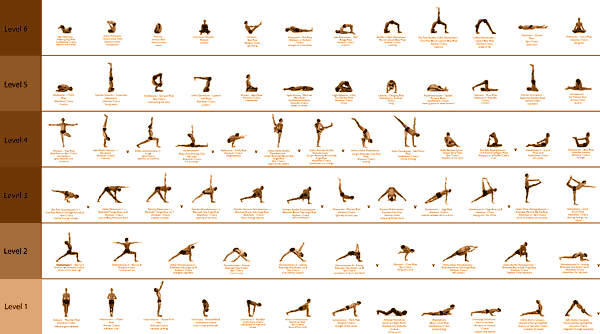
(images below ©Barry Stone)
Tadasana
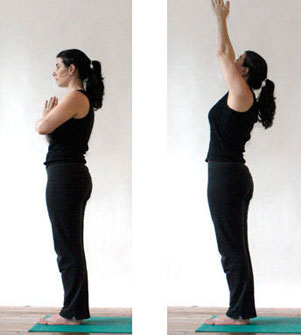
1. Come to stand with the big toes touching.
2. Lift up all your toes and let them fan out, then drop them down creating a wide solid base. You can separate your heels slightly if your ankles are knocking together uncomfortably.
3. Bring your weight evenly onto all four corners of both feet.
4. Let the feet and the calves root down into the floor.
5. Engage the quadriceps and draw them upward, causing your knee caps to rise.
6. Rotate both thighs inward, creating a widening of the sit bones, and tuck your tailbone in between the sit bones.
7. Tone the belly, drawing it in slightly.
8. Widen the collar bones and make sure the shoulders are parallel to the pelvis.
9. The neck is long, the crown of the head rises toward the ceiling, and the shoulder blades slide down the back.
It may seem like you are just standing there, but bringing the body into alignment is hard work. The alignment for Tadasana carries in to many of the standing and inverted poses.
Uttanasana Pose
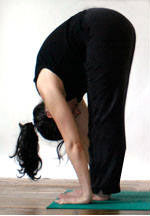
1. From Urdhva Hastasana, swan dive the arms out to the side while folding forward.
2. Make sure the fold come from the hips, deepening the hip creases, and not from the back.
3. Bring the fingertips in line with the toes and press the palms flat.
4. Engage the quadriceps muscles of the thighs. The more you use your quads, the more the hamstrings (the muscles on the back of the thighs) will open up.
5. Bring your weight a little bit forward into the balls of your feet so that your hips stay over the ankles.
6. Let your head hang.
Beginners: Bend the knees if you need to in order to bring the palms flat. Then work on straightening the legs.
Advanced: If you are very open in the hamstrings, bend the elbows out to the sides. If you are holding the pose for a long time, bring the palm flat
Uttanasana Flat Back Pose
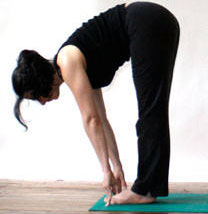
From a Uttanasana Pose, come up to a Flat Back bringing the finger tips to the floor, this is done in inhale.
Cow Pose
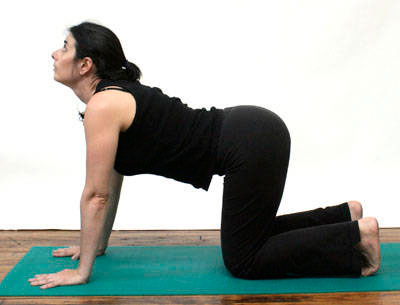
1. Start on all fours, bringing the wrists underneath the shoulders and the knees underneath the hips.
2. Think of the spine as a straight line connecting the shoulders to the hips. Try visualizing the line extending forward through the crown of the head and backwards through the tail bone.
3. Keep the neck the natural extension of the spine.
4. Curl the toes under.
5. Drop the belly.
6. Take the gaze up toward the ceiling.
Cat Pose

1. Release the tops of the feet to the floor.
2. Round the spine.
3. Drop the head.
4. Take the gaze to the navel.
Downward Facing Dog
Press back into Downward Facing Dog. Pedal the legs, bending one knee and then the other, reaching each heel towards the floor. Settle into the pose and hold 5 to 10 breaths. Downward facing dog is done many times during most yoga classes. It is a transitional pose, a resting pose and a great strengthener in its own right. It may be the first yoga pose you encounter as you begin a yoga practice. Downward dog is so prevalent, even people who have never done yoga have probably heard of it.
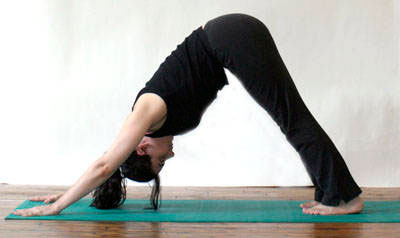
1. Come to your hands and knees with the wrists underneath the shoulders and the knees underneath the hips.
2. Curl the toes under and push back raising the hips and straightening the legs.
3. Spread the fingers and ground down from the forearms into the fingertips.
4. Outwardly rotate the upper arms broadening the collarbones.
5. Let the head hang, move the shoulder blades away from the ears towards the hips.
6. Engage the quadriceps strongly to take the weight off the arms, making this a resting pose.
7. Rotate the thighs inward, keep the tail high and sink your heels towards the floor.
8. Check that the distance between your hands and feet is correct by coming forward to a plank position. The distance between the hands and feet should be the same in these two poses. Do not step the feet toward the hands in Down Dog in order the get the heels to the floor. This will happen eventually as the muscles lengthen.
Lunge
Step the right foot forward next to the right hand, coming into a low lunge. Drop the back knee down to the floor for a nice stretch in both hips.
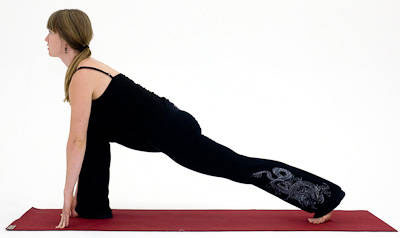
Re-straighten the back leg if you have dropped that knee to the floor. Slowly straighten the front leg as you forward bend over that leg. Try to keep the front foot flat on the floor and don’t force the leg to come straight. Go back and forth between a bent and straight front leg several times. Step back to Downward Dog, and then step the left foot forward next to the left hand and take the lunge on this side. Come back to Downward Dog.
Plank Pose
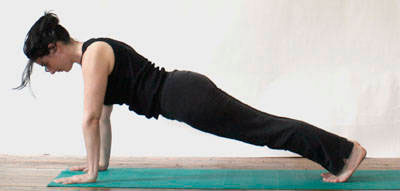
1. From Downward Facing Dog, draw the torso forward until the shoulders are over the wrists and the whole body is in one straight line. This is very similar to the position you would take if you were about to do a push up.
2. Press the forearms and hands firmly down, do not let your chest sink, press back through the heels.
3. Keep the neck in line with the spine and broaden the shoulder blades.
Beginners: Move back and forth between Down Dog and Plank making sure the distance between your hands and feet does not change.
Advanced: Try lifting one leg at a time.
Cobra

Cobra is usually done as part of the Sun Salutation vinyasa sequence. It is can be done as an alternative to Upward Facing Dog in the sequence for beginners.
1. From Knees, Chest, and Chin position, release the tops of the feet to the floor and press them down.
2. Slide your chest forward and up keeping your hands exactly where the were.
3. Roll your shoulders back and lift the chest higher, while keeping the low ribs on the floor.
4. Keep your neck neutral, don’t crank it back.
Beginners: Strongly engaging the legs and pressing them down will help you bring your chest higher.
Advanced: Keeping the chest high, bring the palms off of the floor. Or keep the palms on the floor and start to straighten the arms for a more intense backbend.
Knees, Chest, and Chin – Ashtanga Namaskara

1. From Plank position, drop the knees to the floor.
2. Bring the chest and chin forward and down to the floor, placing the chest right between the hands.
3. Keep the elbows hugging into your sides.
4. The hips should stay high.
Beginners: This pose is like a half push-up, and will help you build the arm strength necessary to move onto Chaturanga Dandasana
Advanced: You may want to include Knees, Chest, and Chin in your first few Sun Salutations as you warm up before going on to Chaturanga.
If you are a beginner:
Exhale – Drop to your Knees, Chest, and Chin
If you are more advanced:
Exhale – Lower down to Chaturanga Dandasana
Sun Salutations
Sun Salutations (Surya Namaskara in Sanskrit) are the core of a Vinyasa style yoga practice. A sun salutation is a series of poses done in succession so that one pose flows into the next. The pace of the flow and how long the poses are held may vary, but the movement is done in accompaniment with the breath. The purpose of the Sun Salutation is to warm up the body for more intense stretches.
See also Yoga Stretching where these poses are used in sequences.